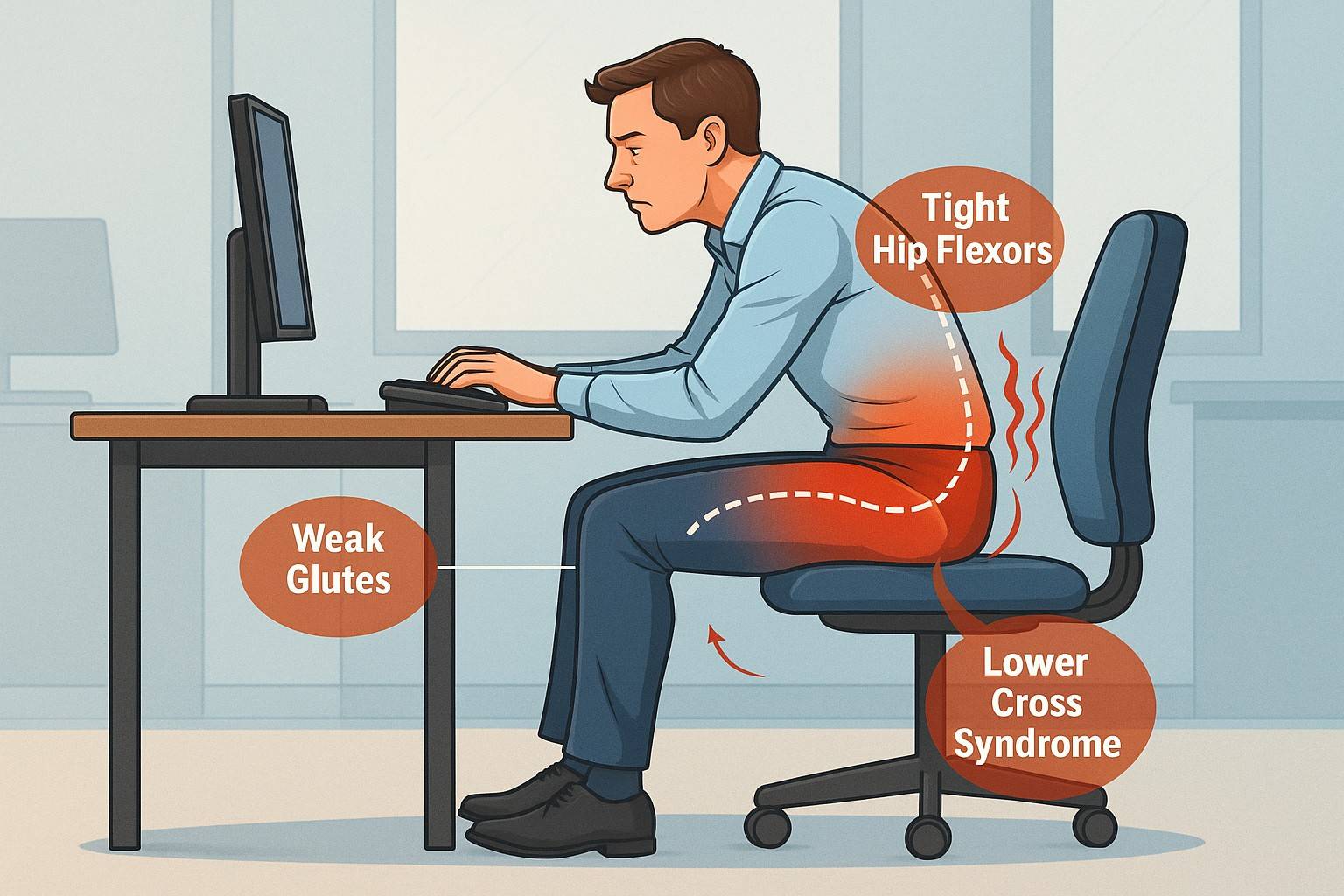Work dynamics have transformed dramatically during the modern era. Deskbound white-collar jobs have become prevalent due to advancements in technology and the growth of information-based industries. The workplace transformation has resulted in more workers developing musculoskeletal problems with Lower Cross Syndrome (LCS) standing out as a significant issue. People who sit for extended periods experience increased cases of a condition that creates muscle imbalances around the lower back and pelvis. Physiotherapy remains essential for LCS treatment and management to enable patients to experience pain-free functioning.
Lower Cross Syndrome represents a postural disorder characterized by muscular imbalances in the lower back and pelvic area. This condition combines weak muscles with tight muscles causing discomfort and potential long-term health issues when not addressed. The classification of LCS usually involves identifying two key muscle imbalances.
1. The hip flexor muscles exhibit tightness specifically in the iliopsoas and rectus femoris regions.
2. Muscle weakness affects the gluteus maximus and gluteus medius muscles along with the rectus abdominis and transverse abdominis muscles.
The erector spinae (back muscles) and hip flexors demonstrate overactivity while the gluteals and abdominals exhibit underactivity resulting in postural abnormalities alongside pain.
Imbalances between muscles result in an anterior pelvic tilt which produces excessive curvature in the lumbar region. The posture causes excessive stress on spinal structures which heightens the chances of developing lower back pain and herniated discs along with other musculoskeletal disorders.
The prevalence of lower cross syndrome has increased among professionals who work in white-collar jobs.
Office-based white-collar jobs require employees to perform desk work which demands extended periods of sitting. The group of white-collar jobs includes roles like accountants, software developers, administrative staff and executives. The growing dependence on computers makes it necessary for professionals in these fields to sit for extended periods during their workday which results in multiple health complications including LCS.
The static work environment of these positions plays an essential role in the development of Lower Cross Syndrome. Here’s how:
1. Prolonged Sitting: Extended sitting time results in hip flexor shortening and gluteal muscle atrophy. The prolonged imbalance between the front and back regions of the body eventually results in anterior pelvic tilt and spinal curvature abnormalities.
2. Lack of Movement: Sedentary work conditions prevent employees from moving and stretching often. Sedentary work conditions prevent activation of lower body muscles especially the glutes while keeping hip flexors in a shortened state thereby increasing muscle imbalances.
3. Poor Posture: Office workers frequently adopt bad sitting positions such as slouching or leaning forward which adds strain to their spine and leads to Lower Cross Syndrome development. Employees who use poorly adjusted desks and chairs that fail to support proper posture often experience these problems.
4. Stress and Tension: Many office positions generate substantial stress and mental exhaustion. Mental strain from work-related stress turns into physical muscle tension which affects the lower back area and plays a role in developing Lower Cross Syndrome.
Physiotherapy serves as an essential therapeutic approach to address and prevent Lower Cross Syndrome.
Physiotherapy remains an essential treatment method to both treat and prevent Lower Cross Syndrome. Physiotherapists aim to achieve proper muscle balance while reducing pain and enhancing posture. The treatment plan includes multiple components for effective management of Lower Cross Syndrome.
1. Postural Education
The initial action to treat LCS involves adjusting posture to a correct position. Physiotherapists teach patients how to maintain correct sitting and standing postures to prevent lower back and pelvic discomfort. This might include:
The pelvis should remain flat without any forward or backward tilt.
Adjust the chair and desk heights along with the computer screen position to maintain proper alignment.
Ergonomics training instructs workers to maintain proper posture by avoiding slouching while keeping their feet flat on the floor and taking regular breaks from sitting.
2. Stretching the Hip Flexors
Physiotherapists target stretching of hip front muscles because tight hip flexors indicate Lower Cross Syndrome. Key stretches include:
Lunges effectively stretch the hip flexors while targeting both the iliopsoas and rectus femoris muscles.
The hip flexor stretch performed on a mat specifically targets the hip flexors by lying down and pulling one leg towards the chest.
Specific psoas stretches focus on the psoas muscle and help to release tension within this deep muscle.
3. Strengthening the Gluteal and Core Muscles
The treatment for muscle imbalances linked to LCS requires strengthening both gluteal and core muscles. Physiotherapists create exercise routines to trigger these muscle groups while building their strength which can include:
The glute bridge exercise targets glute activation and strengthening which tend to be weakened in LCS patients.
Clamshell exercises help to engage the gluteus medius while building strength in the hip muscles.
The plank exercise targets abdominal muscles with a particular focus on the transverse abdominis which tends to be weak in people with LCS.
The dead bug exercise targets core stability and muscle strength to lessen lower back strain.
4. Manual Therapy
Massage therapy and mobilization techniques under manual therapy can aid in reducing muscle tension in the affected areas. This may include:
Trigger point release involves treating muscle tightness by targeting knots specifically found in the hip flexors, lower back, and glutes.
Joint mobilizations enhance pelvis and lumbar spine movement which helps decrease pain and stiffness.
Soft tissue mobilization effectively decreases muscle stiffness and pain in both hip flexors and back area.
5. Education on Active Lifestyle
Physiotherapy for LCS treatment focuses on promoting an active lifestyle. This includes:
Physiotherapists advise people to stand up and stretch while moving around every halfhour to onehour interval to lessen muscle strain.
Engaging in walking and other lowimpact activities helps build muscle flexibility and strength while boosting endurance which leads to improved posture and decreased LCS risk.
Participating in regular exercise activities like swimming, yoga, or cycling can help maintain balanced muscles while preventing musculoskeletal problems.
Prevention Strategies for Lower Cross Syndrome
Preventing Lower Cross Syndrome becomes critical for whitecollar workers who face an increased risk of developing it. Here are some proactive measures:
1. Regular Movement: Daily small movements including standing up, walking and stretching help maintain balanced muscles.
2. Ergonomic Work Setup: A properly adjusted desk, chair, and monitor that support neutral body alignment will help minimize the risk of Lower Cross Syndrome development.
3. Core and Glute Strengthening: By performing exercises that target core and glute strength on a regular basis you can maintain muscle balance and lower your risk of developing LCS.
4. Posture Correction: Good posture habits during sitting, standing, and walking activities help maintain spinal neutrality to prevent LCS formation.
Lower Cross Syndrome frequently affects people who work in sedentary occupations especially those holding white-collar positions. Prolonged sitting combined with poor posture habits and insufficient physical activity results in muscle imbalances which lead to this condition. Physiotherapy provides effective treatment for LCS by utilizing methods such as postural education alongside muscle strengthening exercises and manual therapy combined with stretching. The combination of altering work routines to include frequent movement and participating in specialized physiotherapy enables people to control and avoid Lower Cross Syndrome which results in enhanced health and wellbeing.
– Dr.Prachi Oza, Assistant Professor
Department of Physiotherapy, Madhav University
FAQs
Lower Cross Syndrome is a postural imbalance caused by prolonged sitting and poor ergonomics. It involves tight hip flexors and lower back muscles, combined with weak gluteal and abdominal muscles, leading to anterior pelvic tilt and lower back pain.
White-collar jobs often require prolonged sitting, lack of movement, and poor posture. These factors contribute to muscle imbalances that increase the risk of developing LCS.
Common symptoms include lower back pain, pelvic tilt, stiffness in the hips, weakness in the glutes and core, and poor posture.
Treatment includes physiotherapy with a focus on postural education, stretching tight muscles (like hip flexors), strengthening weak muscles (like glutes and core), manual therapy, and adopting an active lifestyle.
Recommended exercises include:
• Glute bridges
• Planks
• Clamshells
• Lunges
• Dead bugs
• Hip flexor and psoas stretches
Improper desk or chair height and poorly positioned screens lead to slouched sitting, causing strain on the back and pelvic region, which accelerates muscle imbalances associated with LCS.
Yes. Regular movement, ergonomic workstations, core and glute strengthening exercises, and maintaining good posture can help prevent LCS.
No. With proper physiotherapy, lifestyle adjustments, and consistent exercise, most individuals can significantly reduce symptoms or fully recover from LCS.

